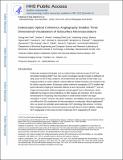Endoscopic Optical Coherence Angiography Enables 3-Dimensional Visualization of Subsurface Microvasculature
Author(s)
Tsai, Tsung-Han; Lee, Hsiang-Chieh; Liang, Kaicheng; Figueiredo, Marisa; Tao, Yuankai K.; Potsaid, Benjamin M.; Jayaraman, Vijaysekhar; Huang, Qin; Cable, Alex E.; Fujimoto, James G.; Mashimo, Hiroshi; Ahsen, Osman Oguz; Giacomelli, Michael Gene; ... Show more Show less
DownloadEndoscopic Optical Coherence.pdf (1.845Mb)
PUBLISHER_CC
Publisher with Creative Commons License
Creative Commons Attribution
Terms of use
Metadata
Show full item recordAbstract
Endoscopic imaging technologies such as confocal laser endomicroscopy and narrow band imaging (NBI) have been used to investigate vascular changes as hallmarks of early cancer in the gastrointestinal tract. However, the limited frame rate and field of view make confocal laser endomicroscopy imaging sensitive to motion artifacts, whereas NBI has limited resolution and visualizes only the surface vascular pattern. Endoscopic optical coherence tomography (OCT) enables high-speed volumetric imaging of subsurface features at near-microscopic resolution, and can image microvasculature without exogenous contrast agents, such as fluorescein, which obliterates the image in areas of bleeding, or after biopsies and resections. OCT has been used for visualizing microvasculature in small animal models and larger vasculature in swine; however, the speed, resolution, and stability of previous systems were not sufficient for 3-dimenstional visualization of microvasculature in endoscopic clinical applications. Herein, we have presented an ultra–high-speed endoscopic OCT technology that achieves >10 times faster imaging speed than commercial systems and high frame-to-frame stability, enabling OCT angiography in the human gastrointestinal tract. Endoscopic OCT angiography of normal esophagus, nondysplastic Barrett’s esophagus (BE) and normal rectoanal junction are demonstrated.
Date issued
2014-08Department
Massachusetts Institute of Technology. Department of Electrical Engineering and Computer Science; Massachusetts Institute of Technology. Research Laboratory of ElectronicsJournal
Gastroenterology
Publisher
Elsevier
Citation
Tsai, Tsung-Han, Osman O. Ahsen, Hsiang-Chieh Lee, Kaicheng Liang, Marisa Figueiredo, Yuankai K. Tao, Michael G. Giacomelli, et al. “Endoscopic Optical Coherence Angiography Enables 3-Dimensional Visualization of Subsurface Microvasculature.” Gastroenterology 147, no. 6 (December 2014): 1219–1221.
Version: Author's final manuscript
ISSN
00165085
1528-0012